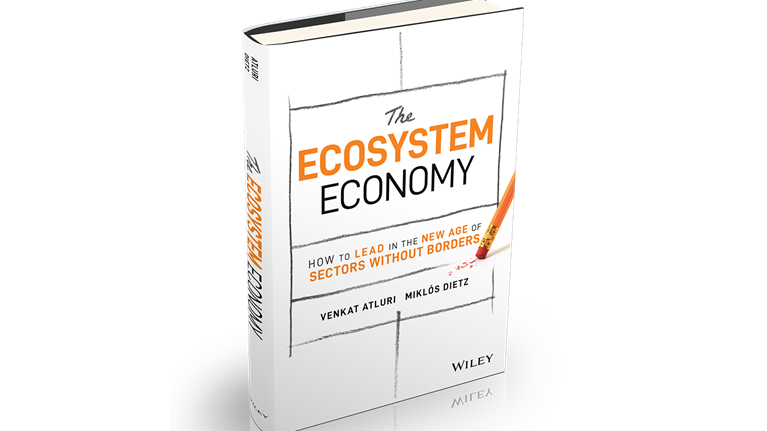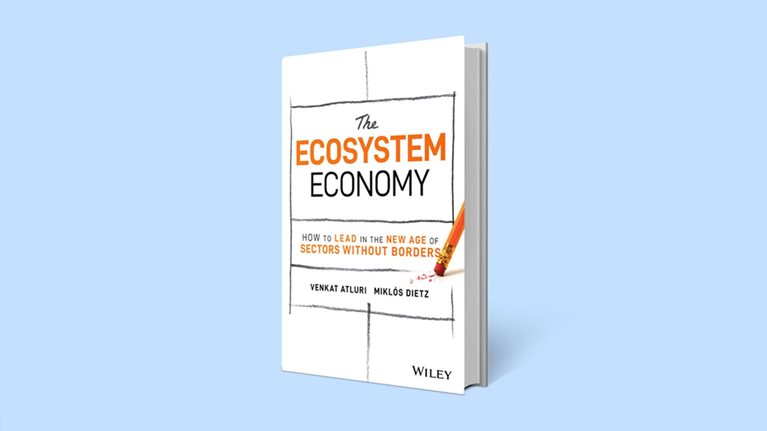We’ve long known that resilient organizations tend to adopt countercyclical strategies to combat downturns and disruptions1 and to outperform peers. Growth interventions are important,2 and building ecosystems in complementary sectors is an increasingly critical growth path—especially as they can rapidly unlock value at potentially lower risk than going it alone.
In fact, while the term “ecosystem strategy” is relatively recent,3 strategically and consistently building cross-sector, customer-centric integrated value propositions through strategic alliances has a long history, especially among technology players such as Alibaba, Amazon, and Microsoft. Today, it’s mainstream: for most companies across most sectors, ecosystem building is a critical pathway to build growth and resilience, with close to 50 percent of resilience leaders pursuing ecosystem strategies.4
That’s not to suggest ecosystems—interconnected sets of services through which users can fulfill a variety of cross-sectoral needs in one integrated experience5—are easy to build. Our analysis shows just 10 to 15 percent of incumbents manage to generate truly distinctive noncore revenue from their ecosystem efforts. But the opportunity of getting it right is huge: our latest analysis shows the integrated network economy could represent a $100 trillion value pool by 2030, or about a third of the world’s total sales output (Exhibit 1).

Our experience shows that ecosystem building offers tangible near- and long-term benefits and customer willingness to use ecosystem services from incumbents is high (see sidebar, “Now is the time for incumbents to pursue ecosystem strategies”). Winners take a number of specific actions to capture meaningful business value.
Long-term: How ecosystem strategies build resilience
Ecosystem building is a proven strategy for delivering outperformance and value creation in the long term, especially through two principal routes:
- Diversification into new value pools. Ecosystems can unlock significant new revenue streams from outside an incumbent’s core operations, as well as secondary opportunities including data monetization (such as through insights and advertisements). They can also be a catalyst for bringing new capabilities to an organization, such as modernizing the technology stack, creating cutting-edge data-and-analytics capabilities, or enhancing partnership management capabilities for the future. For example, North American telco Telus leveraged its core and connectivity capabilities to expand into different verticals such as business, healthcare, home security, agriculture, and education. These ecosystem initiatives now generate 21 percent of total company revenue and have enabled Telus to move into higher growth sectors for the future. Among other factors, the ecosystem strategy also contributed to higher valuations for Telus than its telco peers.6
- Improvement in valuation multiples. The other effect is on an incumbent’s valuation, given ecosystem efforts put the organization on a growth trajectory that may not be possible within the primary industry or that may even position the incumbent more like a platform player. It is important to note that most of the benefit accrues only once adjacent services are mature and meaningfully contribute to the balance sheet, thus indicating the organization’s commitment. One Latin American retailer, for instance, transformed from a brick-and-mortar chain to an ecosystem orchestrator over a period of five years. During this time, it became the leading e-commerce player in its home market and introduced several services beyond retail, including financial services, logistics, billing, and advertising technology. Before embarking on this journey, its P/E ratio was below its peers’. By 2022, it was double that of the same peer group.
Near-term: How ecosystems enhance customer value and accelerate growth
Ecosystems are sometimes viewed as medium- to long-term strategies. Yet ecosystem efforts also drive tangible business impact in the near term by delivering on critical customer priorities:
- Accelerated customer acquisition. Companies can deploy ecosystem strategies to acquire new customers across new segments, such as improving the customer value proposition by adding complementary products and services, enhancing digital channels, forming a strategic customer acquisition partnership, or simply enhancing their presence on others’ platforms. European bank ING Germany’s partnership with Amazon to provide merchants with financing solutions was in large part responsible for the 30 percent volume increase in a year of ING Germany’s small and medium-size enterprise loans portfolio.
- Enhanced customer loyalty. Ecosystem strategies can rapidly and significantly enhance customer loyalty, or “stickiness.” This is driven by improving the digital customer experience, bundling services and products from across sectors in integrated customer journeys, and offering higher-frequency touchpoint services with existing ones. German energy provider E.ON has been facing a number of market challenges in recent years, including decarbonization and slow growth at its core. To address these, the company took an active role in shaping Europe’s energy transition and finding new adjacent growth opportunities. Due to the war in Ukraine, cost and energy security became important considerations for consumers, in addition to sustainability. Doubling down on these behavioral changes, E.ON rapidly scaled its Future Energy Home solutions,7 capturing a significant share of a fast-growing market and leaving the company booked for close to a year in advance. These value propositions helped build much deeper customer relationships and more frequent customer engagement through new digital-service offerings.
- Richer customer insights. By broadening the proposition and improving the experience, ecosystem moves can generate richer customer data to act on—especially in areas where it can be complemented with additional third-party data. The value it can potentially drive cuts across multiple use cases, including personalization to improve the customer experience; cross-selling and up-selling to increase share of wallet; and even operational improvements across product planning, logistics, and customer service. For example, a consumer goods company launched a B2B2C platform to help small retailers create a personalized digital relationship with customers. The offering helps gather valuable insights from end users and enable better cross-selling opportunities across the company’s core portfolio of products. The platform now represents 10 to 20 percent of the company’s digital sales and contributes to improved operational efficiencies.
How to overcome implementation challenges
While the benefits of ecosystems are increasingly clear to organizations across sectors, building successful ones can be complex and many organizations fall short of reaching the impact they set out to achieve. Our analysis of 100 incumbent companies’ ecosystem initiatives found while 55 percent gained traction with customers, only about 10 to 15 percent were able to generate more than 5 percent of total revenue from ecosystem value propositions (Exhibit 2).

How can incumbents avoid being in the 85 percent that fail to achieve significant impact? While we’ve done extensive work on outlining the recipe for successful ecosystem efforts,8 in our experience there are six efforts that are most crucial for winning:
- Assess complementary sectors to play in. It is critical to deeply assess which ecosystems are the most attractive, examining value pools9 and matching opportunities with the company’s core assets and growth ambition. With the right initial use cases in prioritized sectors, significant value can be generated early, charting a path to delivering on the broader end-state vision. For example, one insurer has pragmatically mapped out value pools close to (but beyond) insurance and prioritized the health, mobility, and broader financial-services spaces to play in. It launched tangible initial use cases, generating client traction early on—use cases that later became the cornerstone of the company’s wide-reaching ecosystem vision.
- Focus on value for the customer from the start. Aim for a meaningful quantum leap in customer experience10 and true value delivered. Test your thinking with real customers early on. A consumer packaged goods company in the sports industry acquired a tech startup to augment its physical product range and improve customer engagement. However, there was a disconnect between the sports app’s features and the needs of the company’s core customers, which meant the desired synergies were never achieved and the startup was ultimately sold. By prioritizing product features over understanding the underlying needs of customers, businesses risk creating a fragmented and unsatisfactory experience.
- Find the right partners. Find partners who share the company’s principles and handle customers the same way. In economic downturns, it’s also advisable to take advantage of M&A opportunities in securing new capabilities and talent that will enable future ecosystem growth. For example, a European property agency designing an end-to-end home sales experience carefully sought the right partners it could collaborate with in the long term. It implemented a joint management approach that reinforced those relationships through measures such as thoughtful onboarding, the integration of partners via two-way APIs, and the establishment of clear value-sharing agreements.
- Strike balance to govern your ecosystem. Depending on an organization’s innovation culture, its capabilities, and the strategic ambition of the initiative, companies need to provide enough independence for the new entity to move rapidly within the right guardrails but still have enough connections to build on core strengths. Consider a financial institution that launched a new beyond-the-core venture. While it achieved early successes, cultural clashes and management-initiated reorganizations (a new venture was folded into an established business unit) hindered decision making and slowed innovation.
- Integrate data across your ecosystem for clear business use cases. Leverage the data that can be collected through ecosystem initiatives and partners. These can reinforce existing operations or can become the foundation for completely new value propositions. One insurer launched a successful health and well-being loyalty program, using data gathered as a result of frequent customer engagement to reduce insurance claims and design a new breed of financial-services products.
- Measure the right impact metrics. Focusing on traditional KPIs may not capture the true benefits of ecosystem efforts. Successful large technology players consider the roles that each portfolio asset plays in their overall ecosystems. Some initiatives purposefully make losses but serve as traffic entry points; others may have an enabler role to make sure revenue and profit generation can be maximized elsewhere. Companies need to look across the entire value generation funnel—from customer traffic, to profit generation, to potential valuation uplift—and select the right KPIs accordingly.
During downturns, many incumbents end up with most of their efforts focused on the near term. Ecosystem building can deliver significant long-term and near-term benefits. And with a global integrated economy worth potentially up to $100 trillion by the end of the decade—as well as significant consumer openness across sectors—the time to act is now.



